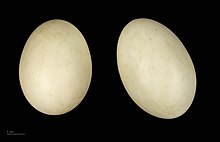タテガミガン
表示
| タテガミガン | ||||||||||||||||||||||||
|---|---|---|---|---|---|---|---|---|---|---|---|---|---|---|---|---|---|---|---|---|---|---|---|---|
 タテガミガン(オス)
| ||||||||||||||||||||||||
| 分類 | ||||||||||||||||||||||||
| ||||||||||||||||||||||||
| 学名 | ||||||||||||||||||||||||
| Chenonetta jubata (Latham, 1802) | ||||||||||||||||||||||||
| 和名 | ||||||||||||||||||||||||
| タテガミガン | ||||||||||||||||||||||||
| 英名 | ||||||||||||||||||||||||
| Australian Wood Duck Maned Duck |


タテガミガン(鬣雁、学名:Chenonetta jubata)は、カモ目カモ科に分類される鳥類の一種。
分布
[編集]形態
[編集]全長45-51cm。小型のガン類のように見える。
オスは頭部が焦げ茶色ので胸部は灰色でまだら模様がある。メスは眉斑と下眼線が白く、オスと同様に胸部はまだら模様がある。雌雄とも初列風切りが黒く、白い翼鏡のある灰色の羽を持つ。
生態
[編集]たいてい群れで生活し、池や沼付近の草地、芝生、グラウンドなどで草や草の実、種を食べる。市街地の公園でも観られる。カモ類にの中では、珍しくあまり泳がない。
繁殖期は北部は周年、南部は春から秋にかけてで、樹洞の中に8-12個の卵を産卵する。繁殖中は、雛がある程度大きくなるまでは他の群れから離れ、家族単位で行動する。
分類
[編集]Chenonetta属では唯一の現生種である。
伝統的にカモ亜科に置かれるが、実際にはツクシガモ亜科に属するとされることもある[1]。また、おそらくクビワコガモは近縁種である[2]。
ニュージーランドの飛べないカモ類であるFinsch's Duck(Chenonetta finschi)は以前はEuryanas属の唯一の種であると考えられていたが、現在はChenonetta属であるとされている[3] しかし、ニュージーランドの鳥相が正式に調査される以前、おそらく1870年代後半に絶滅した[4]。
絶滅危惧評価
[編集]- LEAST CONCERN (IUCN Red List Ver. 3.1 (2001))
参考文献
[編集]- ^ Sraml, M.; Christidis, L.; Easteal, S.; Horn, P. & Collet, C. (1996): Molecular Relationships Within Australasian Waterfowl (Anseriformes). Australian Journal of Zoology 44(1): 47-58.
- ^ Johnson, Kevin P. & Sorenson, Michael D. (1999): Phylogeny and biogeography of dabbling ducks (genus Anas): a comparison of molecular and morphological evidence. Auk 116(3): 792--805.
- ^ Worthy, Trevor H. & Olson, Storrs L. (2002): Relationships, adaptations, and habits of the extinct duck 'Euryanas' finschi. Archived 2007年10月19日, at the Wayback Machine. Notornis 49(1): 1--17.
- ^ Tennyson, A. & Martinson, P. (2006) Extinct Birds of New Zealand Te Papa Press,Wellington ISBN 978-0-909010-21-8
- ^ Chenonetta jubata (Species Factsheet by BirdLife International)
- Madge, Steve & Burn, Hilary (1987): Wildfowl : an identification guide to the ducks, geese and swans of the world. Christopher Helm, London. ISBN 0-7470-2201-1
- BirdLife International (2004). Chenonetta jubata. 2006 IUCN Red List of Threatened Species. IUCN 2006. Retrieved on 11 May 2006. Database entry includes justification for why this species is of least concern
- Field Guide to Australian Birds, Steve Panish Publishing, 2004
外部リンク
[編集]- Chenonetta jubata Maned Duck(bird videos by the Internet Bird Collection)

